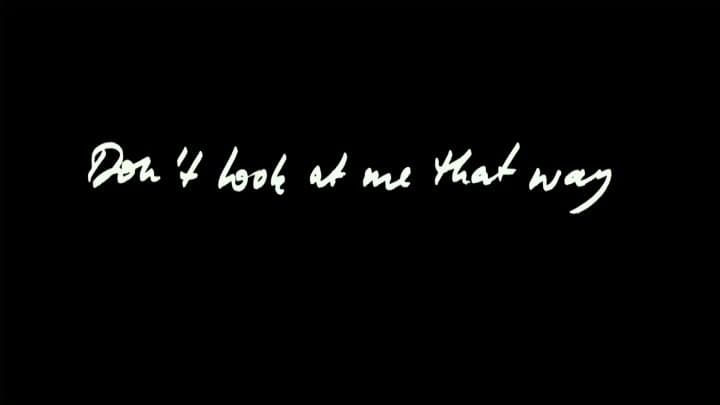“Don’t Look At Me That Way,” directed by Uisenma Borchu and released in 2015, is a provocative and introspective drama that explores themes of identity, sexuality, and cultural conflict. The film follows the story of Hedi, a Mongolian woman living in Germany, who becomes entangled in a complex relationship with her neighbor Iva and Iva’s daughter. With Borchu herself starring as Hedi and Catrina Stemmer as Iva, the film delves deeply into the emotional and psychological landscapes of its characters, offering a raw and unfiltered portrayal of desire and human connection.
Table of Contents
![Don't Look At Me That Way (2015) [DVD Review] 2 Don't Look At Me That Way (2015) [DVD Review] 1](https://andersonvision.com/wp-content/uploads/2024/06/dont-look-at-me-that-way-dvd.jpg)
Don’t Look At Me That Way is a fascinating movie
The creation of “Don’t Look At Me That Way” is rooted in Uisenma Borchu’s personal experiences and artistic vision. Borchu, a Mongolian-born filmmaker living in Germany, sought to explore the intersection of her cultural heritage and contemporary European life. The film’s screenplay, written by Borchu, weaves together autobiographical elements with fictional narratives, creating a story that is both intimate and universal.
Filming took place in Munich, Germany, with a small but dedicated crew. The production’s limited budget necessitated a minimalist approach to the film’s visuals and settings, which ultimately enhanced the story’s focus on character and emotion. Cinematographer Sven Zellner’s work is instrumental in capturing the film’s raw and naturalistic aesthetic, emphasizing the close, often claustrophobic, interactions between the characters.
Let’s talk about it
“Don’t Look At Me That Way” centers on Hedi (Uisenma Borchu), a Mongolian woman living in Germany, who leads a solitary and introspective life. Her existence is disrupted when she forms an unexpected bond with her neighbor Iva (Catrina Stemmer) and Iva’s young daughter, Sophia. As Hedi becomes more involved in their lives, a complicated and intense relationship develops between her and Iva.
The film explores the shifting dynamics of this relationship, marked by passion, jealousy, and power struggles. Hedi’s presence forces Iva to confront her own desires and insecurities, leading to a tumultuous and transformative journey for both women. The narrative delves into themes of identity, cultural dislocation, and the search for belonging, offering a poignant and sometimes unsettling look at human connections.
This will be your first time seeing most of the cast
The casting of “Don’t Look At Me That Way” brings together a small but powerful ensemble that drives the film’s emotional core. Uisenma Borchu, as Hedi, delivers a deeply personal and compelling performance. Her portrayal captures Hedi’s complexity, vulnerability, and fierce independence, making her a captivating and relatable protagonist.
Catrina Stemmer’s performance as Iva is equally compelling. Stemmer brings depth and nuance to the role, effectively conveying Iva’s internal conflicts and emotional struggles. Her chemistry with Borchu adds authenticity and intensity to their on-screen relationship, creating a dynamic and engaging narrative.
The supporting cast, including Schornsteinmayer as Sophia, enhances the film’s intimate and realistic atmosphere. The naturalistic performances and interactions between the actors contribute to the film’s raw and unfiltered portrayal of its themes.
![Don't Look At Me That Way (2015) [DVD Review] 4 Don't Look At Me That Way (2015) [DVD Review] 3](https://andersonvision.com/wp-content/uploads/2024/06/dont-look-at-me-that-way-16.jpg)
Uisenma Borchu is a revelation
Uisenma Borchu’s performance as Hedi is undeniably the standout of “Don’t Look At Me That Way.” Borchu’s ability to convey a wide range of emotions, from vulnerability to defiance, makes her portrayal both compelling and deeply affecting. Her on-screen presence and the authenticity she brings to the role anchor the film and drive its emotional impact.
Catrina Stemmer’s portrayal of Iva is another highlight. Stemmer’s nuanced performance captures Iva’s complexity, from her initial curiosity about Hedi to the deeper, more turbulent emotions that arise as their relationship evolves. The emotional depth and vulnerability Stemmer brings to the role enhance the film’s exploration of desire and identity.
The young actress playing Sophia delivers a natural and believable performance, adding a layer of innocence and authenticity to the story. Her interactions with Borchu and Stemmer contribute to the film’s realistic portrayal of human relationships and emotional dynamics.
Sven Zellner Hive represent!
The cinematography of “Don’t Look At Me That Way,” led by Sven Zellner, is a key element of the film’s visual style. Zellner’s use of natural lighting and handheld camera work creates an intimate and immersive atmosphere, emphasizing the raw and unfiltered nature of the story. The film’s visual style is marked by its attention to detail and its focus on the physical and emotional landscapes of the characters.
The use of close-ups and tight framing highlights the intensity and intimacy of the characters’ interactions, drawing the audience into their world. The film’s minimalist approach to visual effects and settings enhances its focus on character and emotion, creating a powerful and immersive viewing experience.
The moments we loved
Several key scenes in “Don’t Look At Me That Way” stand out for their emotional and narrative impact. The initial meeting between Hedi and Iva sets the stage for their complex relationship. This scene effectively captures the curiosity and attraction between the characters, establishing the central dynamic of the film.
A pivotal scene occurs when Hedi and Iva’s relationship reaches a turning point, marked by a moment of vulnerability and raw emotion. The intensity of their interactions and the depth of their emotional connection are powerfully conveyed through the performances and cinematography.
The film’s climax, which explores the culmination of Hedi and Iva’s relationship, is a standout moment. The tension and emotional stakes are heightened, creating a powerful and cathartic conclusion to their journey. The use of visual and auditory elements in this scene enhances its impact, making it a memorable and significant part of the narrative.
If I liked this movie, what else would I like?
“Don’t Look At Me That Way” can be compared to other films that explore themes of identity, sexuality, and cultural conflict. Films like “Blue Is the Warmest Color” and “Call Me by Your Name” share similar themes of intense, transformative relationships and the exploration of desire and identity. Both films use their central relationships to drive the narrative and explore complex emotional landscapes.
Another comparable film is “A Fantastic Woman,” which also explores themes of identity and societal acceptance. Both films feature protagonists navigating personal and cultural conflicts, offering a poignant and introspective look at their journeys.
“Pariah,” directed by Dee Rees, is another film with thematic and stylistic similarities. Both films explore the intersections of identity, sexuality, and cultural expectations, providing a deep and engaging look at the protagonists’ struggles and transformations.
![Don't Look At Me That Way (2015) [DVD Review] 6 Don't Look At Me That Way (2015) [DVD Review] 5](https://andersonvision.com/wp-content/uploads/2024/06/dont-look-at-me-that-way-13.jpg)
What films should I make a double feature with Don’t Look At Me That Way?
For a thematic double feature, pair “Don’t Look At Me That Way” with “Blue Is the Warmest Color.” Both films offer raw and emotionally resonant portrayals of intense relationships and the exploration of desire and identity. The thematic and stylistic parallels create a cohesive and engaging viewing experience.
“A Fantastic Woman” is another excellent companion film. The exploration of identity, societal acceptance, and personal transformation resonates with the themes of “Don’t Look At Me That Way.” The strong performances and rich narratives of both films provide a thought-provoking and immersive experience.
For a more contemporary pairing, consider “Call Me by Your Name.” The exploration of desire, identity, and the impact of transformative relationships complements the narrative and style of “Don’t Look At Me That Way.” The similarities in their protagonists’ journeys and the blend of character-driven storytelling make for an engaging and emotionally resonant double feature.
Yes, we have been asked some questions about this film
Q: Is “Don’t Look At Me That Way” based on a true story? A: While the film is not strictly autobiographical, it is inspired by Uisenma Borchu’s personal experiences and explores themes that are deeply personal to her.
Q: Where was “Don’t Look At Me That Way” filmed? A: The film was primarily shot in Munich, Germany, with locations and settings that reflect the urban environment of the characters’ lives.
Q: Is “Don’t Look At Me That Way” suitable for children? A: The film is rated R for sexual content, language, and thematic elements, making it more suitable for mature audiences.
Q: Who directed “Don’t Look At Me That Way”? A: Uisenma Borchu directed the film, bringing her personal vision and experiences to the project.
Q: What is the runtime of “Don’t Look At Me That Way”? A: The runtime of the film is approximately 88 minutes.
Q: Are there any notable cameos in “Don’t Look At Me That Way”? A: While the film focuses on its main cast, the performances of the supporting actors contribute to the film’s intimate and realistic atmosphere.
Let’s talk about the recent DVD release
In 2024, “Don’t Look At Me That Way” received a DVD release, providing fans and new viewers with an opportunity to experience this intimate and provocative film in a new format. The DVD release includes a high-quality transfer of the film, ensuring that the raw and naturalistic cinematography is presented with clarity and detail.

![Into The Blue (2005) [Blu-ray review]](https://andersonvision.com/wp-content/uploads/2024/06/into-the-blue-blu-ray-1.jpg)
